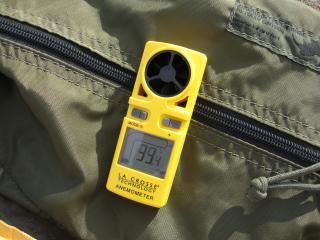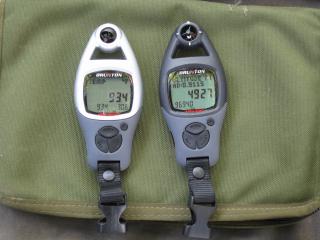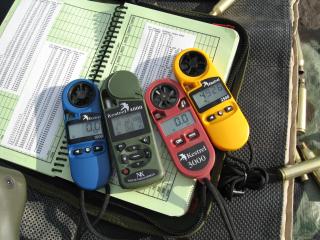
For the precision long-range shooter employing a bolt-action sniper rifle, however, monitoring the wind and environment is critical to making hits. Both law-enforcement and military employment of precision rifles is such that first-round hits are paramount; shooting multipe rounds is often unacceptable because the target will be alerted to the shooter's presence and react.
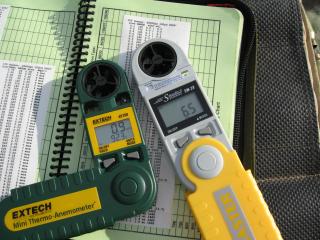
The second way the environment affects the path is by slowing the bullet's velocity due to air friction or drag. The drag on a bullet is higher the faster it goes, which means that a bullet starts out at a high velocity from the muzzle, but rapidly slows. As the bullet slows, the rate of deceleration slows as well. If the atmosphere has a higher density, which means the air is "thicker", the bullet will slow more rapidly than in thin air. This means that a bullet will decelerate faster on a cold day at sea level than it will on a hot day at 7,000 feet altitude in the mountains. As soon as the bullet leaves the
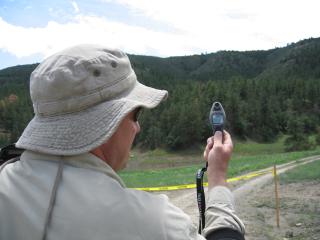

What does all this mean in practical terms? The precision long-range rifle shooter needs to accurately estimate wind and keep track of environmental conditions in order to make first-round hits. Thankfully, there are some technological tools available which ease this task. The most basic tool is the hand-held wind-meter (or anemometer) which can measure the wind speed at the shooter's position.
The benefit of the wind-meter is that it provides the shooter an accurate measure of wind velocity, however, the big limitation is that it only provides information about the current position. Wind is often different from one location to the next, and the bullet may pass through several different wind conditions along its path. If the wind at the shooter is 3 mph left to right, but it switches to 10 mph right to left 100 yards downrange, a left hold calculated at the shooter's position will result in a miss.
Even with this limitation, the hand-held wind-meter can provide a baseline wind condition on which the shooter can base his down-range corrections. Also, after playing around getting wind readings in different conditions, the shooter will eventually learn what wind indicators such as tactile feel, grass and leaf deflection, and mirage correspond to in terms of wind speed (mph). By correlating what 5 mph "feels like", he is better prepared to accruately guess wind conditions in the future.
As the shooter arrives at his position, he pulls gear out of his drag bag such as his data book, range-finder, shooting support, and in some cases additional concealment materal. As he builds his range card, it is a good time to whip out the wind-meter to take a baseline reading of direction and wind speed, and annotate it on the card. As he waits and observes, he needs to keep track of local wind changes, and make judgements about wind conditions down range.
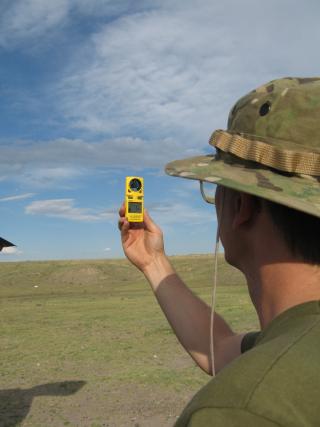
Stepping up from the basic wind-meter, there are several portable environmental stations available to the long-range shooter. Some such as the Speedtech Skymaster offer temperature or altitude, while top-end models like the Kestrel 4000 measure and report just about every atmospheric parameter one could wish for. I got my hands on nine different devices for evaluation.
La Crosse instruments has a very simple and inexpensive Hand-held Anemometer for about fifty dollars. It is the most compact of the units tested, and the cheapest. It can be used to effectively monitor both the wind speed, and the temperature, and is pretty easy to operate.
Extech's Mini-Anemometer measures wind speed, temperature, and relative humidity. Its physical size is amongst the largest of the reviewed units. Speedtech's Skymaster looks and operates very like the Extech, but it can also measure station pressure and altitude. Both of these units have fold-out protective cases, which cover both the impeller, sensors, and controls. Their downside is that the controls are less user friendly than some of the other units tested.
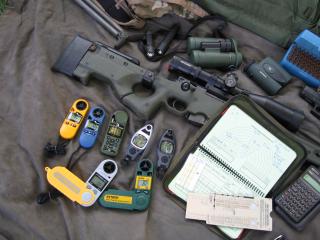
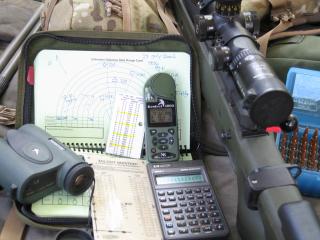
Which is right for you? If you want full wind, temperature, altitude and density altitude, there are only two choices: the Brunton ADC Pro and the Kestrel 4000. Of those, I prefer the 4000 because it is easier to read and has more features. If its price is too steep, the ADC Pro does the job. If all you need is a wind and temperature measurement device, the La Crosse Hand-Held Anemometer cannot be beat for the price.
| Manufacturer | Model | Wind speed | Temperature | RH | station pressure | altitude | Density altitude | Impeller protection | Ease of use | Price | Points | Score |
| La Crosse | Hand-Held Anemometer | X | X | ** | $49.95 | 4 | 8.008008 | |||||
| Extech | Mini-Anemometer | X | X | X | X | * | $129.00 | 5 | 3.875969 | |||
| Speedtech | Skymaster SM-28 | X | X | X | X | X | X | * | $171.00 | 7 | 4.093567 | |
| Brunton | ADC Wind | X | X | ** | $79.00 | 4 | 5.063291 | |||||
| Brunton | ADC Pro | X | X | X | X | X | X | ** | $249.00 | 8 | 3.212851 | |
| Kestrel | 1000 | X | X | *** | $89.00 | 5 | 5.617978 | |||||
| Kestrel | 2500 | X | X | X | X | X | *** | $169.15 | 8 | 4.72953 | ||
| Kestrel | 3000 | X | X | X | X | *** | $179.00 | 7 | 3.910615 | |||
| Kestrel | 4000 | X | X | X | X | X | X | X | *** | $329.00 | 10 | 3.039514 |
| Note: Some atmospheric measures which are not relevant to long-range trajectory were omitted from the table, such as heat index and wind chill. | ||||||||||||
Brunton www.brunton.com Extech Instruments www.extech.com La Crosse Instruments www.lacrosse-psmall.com Nielsen-Kellerman (Kestrel) www.nkhome.com Speedtech Instruments www.speedtech.com
